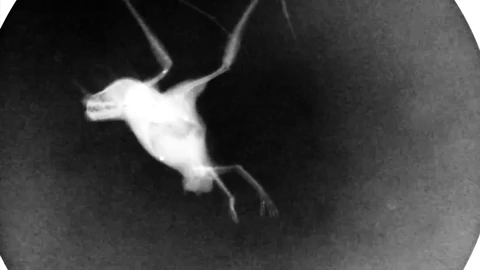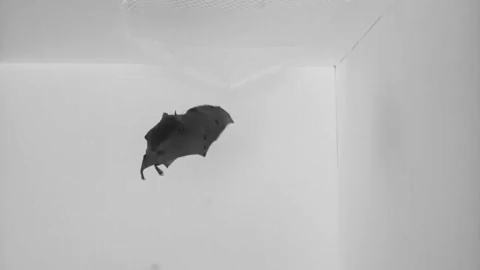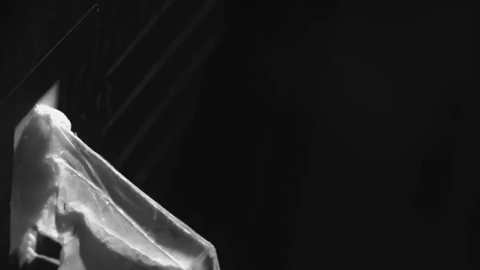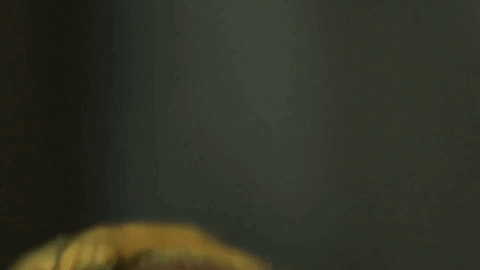Need more bats? Learn about all the amazing things bats can do in our radio interview with Sharon Swartz and Cynthia Moss, and check out a spotlight on batty science.
You’d think that bats and birds fly in similar ways—in fact, many scientists used to consider bat flight a minor variation of bird flight. But, with the aid of high-speed video, researchers have discovered that bat flight is much more complex than initially thought.
Sharon Swartz, a professor of biology at Brown University who studies bat flight and the structure of their wings, and Kenny Breuer, a professor of engineering at Brown University who studies animal flight and fluid mechanics, teamed up to study how these tiny mammals actually fly. Their research lab includes an eclectic mix of high speed cameras, motion tracking, flight corridors, wind tunnels (or a “treadmill for flying animals,” as Swartz puts it), and more to solve this batty mystery.
“When we first started, really very little was known about the precise nature of bat flight,” Breuer says. “We’re really interested in how [bats] have evolved to generate these kinds of forces of motions.”

So, how exactly does bat flight differ from bird flight? For one, bats have way more flexibility and control over their wings—bats have a whole hand in theirs, and are made of muscle and skin. Bird wings, by comparison, are a “relatively stiff airfoil,” says Swartz.
“That allows [bats] to change the conformation and shape of the wing with incredible dexterity and precision,” says Breuer.
“We don’t usually think of skin as being a muscular organ,” explains Swartz. “But the skin of the wing membranes of bats is invested with a whole series of muscles.” Bats can use these muscles to change how stiff the skin in their wing membrane is, allowing them to have minute control over their flight path.
Unlike bird wings, “[bat wings] bend, flex, and puff out,” says Breuer. This manifests in flight behaviors that are unique to bats, like being able to land upside down. “They have to slow down. They have to flip themselves upside down and land hanging onto the ceiling or hanging onto a tree roost. It’s like doing a high dive backwards,” says Breuer.

Due to the control on their wings, bats are able to recover quickly from the challenges of flight, like gusts of wind. The researchers tested this by constructing an apparatus of lasers and air jets. When the bat flew through the laser beams, it triggered a puff of air, aimed directly at the bat.
“We find that even [with] really strong gusts of wind, they recover stability in less than a single wing-beat. So what we’re trying to understand now is, what are the mechanisms that they used to recover so quickly?” says Swartz.

To find the answers, Swartz and Breuer use the motion-capture data to reconstruct the bats’ wing movement inside the computer—and even make mechanical, robotic wings that mimic the movements of bats. The mechanical wings allow them to run tests “that we can’t ask the animals to do,” Breuer says. “And it does provide a lot of inspiration and ideas of things that we might try for building robotic flying vehicles.”
The researchers still have several questions they hope to answer: How did flying animals evolve different methods of flight? Do the bats actively control the wing when reacting to a gust, or are the movements passive?
Swartz finds it all compelling. “I love those moments where you’ve recorded something that no one has seen before, a moment of insight into the natural world. It doesn’t matter how tiny it is. There’s nothing like that.”

Credits
Produced by Luke Groskin
Article by Daniel Peterschmidt
Music by Audio Network
Footage ands Stills Provided by Kenny Breuer and Sharon Swartz
Joe Bahlman, Atilla Bergou, David Boerma, Rhea von Busse, Jorn Cheney, Nick Hristov, Tatjana Hubel, Nicolai Konow, Lauren Reimnitz, Andrea Rummel, Cosima Schunk, Dave Willis, Dan Riskin, Hamid Vejdani. Bat Research supported by NSF, AFOSR and Brown University
All procedures involving animals were performed in an AAALAC-accredited facility in accordance with the Guide for the Care and Use of Laboratory Animals and approved by the Brown University Institutional Animal Care and Use Committee.
Meet the Producers and Host
About Luke Groskin
@lgroskinLuke Groskin is Science Friday’s video producer. He’s on a mission to make you love spiders and other odd creatures.
About Dee Peterschmidt
Dee Peterschmidt is a producer, host of the podcast Universe of Art, and composes music for Science Friday’s podcasts. Their D&D character is a clumsy bard named Chip Chap Chopman.